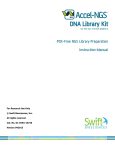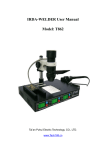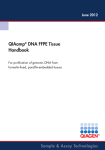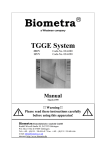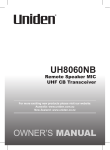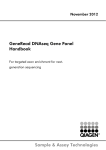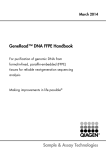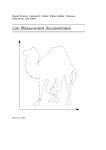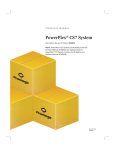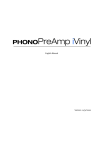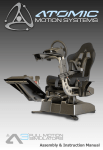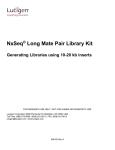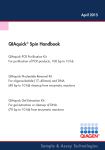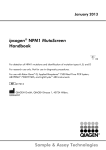Download PreHB Template Word 122011
Transcript
March 2013 QIAGEN GeneRead™ Library Prep (L) Handbook For preparation of DNA libraries for nextgeneration sequencing (NGS) applications that use Ion Torrent™ instruments from Life Technologies® Sample & Assay Technologies QIAGEN Sample and Assay Technologies QIAGEN is the leading provider of innovative sample and assay technologies, enabling the isolation and detection of contents of any biological sample. Our advanced, high-quality products and services ensure success from sample to result. QIAGEN sets standards in: Purification of DNA, RNA, and proteins Nucleic acid and protein assays microRNA research and RNAi Automation of sample and assay technologies Our mission is to enable you to achieve outstanding success and breakthroughs. For more information, visit www.qiagen.com. Contents Kit Contents 4 Shipping and Storage 6 Intended Use 6 Safety Information 6 Quality Control 6 Introduction 7 Principle and procedure 7 Description of protocols 8 Equipment and Reagents to Be Supplied by User Important Notes 9 10 DNA preparation and quality control 10 High-quality DNA is essential for obtaining good sequencing results 10 Protocols End Repair, Adapter Ligation, and Cleanup and Size Selection of DNA 11 Optional Amplification of Library DNA 15 Troubleshooting Guide 17 References 18 Appendix A: Barcode Sequences for the GeneRead Adapter L Set 12-Plex 19 Ordering Information 20 QIAGEN GeneRead Library Prep (L) Handbook 03/2013 3 Kit Contents GeneRead™ DNA Library L Core Kit Catalog no. 180462 Number of reactions 12 End Repair Buffer, 10x 50 µl Ligation Buffer, 2x 600 µl End Repair Enzyme Mix 24 µl Ligation and Nick Repair Mix 48 µl dNTP Mix (10 mM) 55 µl RNase-free Water 1.9 ml Quick Start Protocol 1 GeneRead DNA L Amp Kit (100) Catalog no. 180485 Number of reactions 100 Primer Mix, 10 µM 150 µl HiFi PCR Master Mix, 2x 2 x 1.25 ml RNase-free Water 1.9 ml Quick Start Protocol 1 GeneRead DNA Adapter L Set 1-plex Catalog no. Number of reactions Adapter, 50 µM Quick Start Protocol 4 (12) (12) 180922 12 24 µl 1 QIAGEN GeneRead Library Prep (L) Handbook 03/2013 GeneRead DNA Adapter L Set 12-plex* Catalog no. (72) 180994 Number of reactions 72 Adapter BcGen, 25 µM 144 µl Adapter Bc1, 25 µM 12 µl Adapter Bc2, 25 µM 12 µl Adapter Bc3, 25 µM 12 µl Adapter Bc4, 25 µM 12 µl Adapter Bc5, 25 µM 12 µl Adapter Bc6, 25 µM 12 µl Adapter Bc7, 25 µM 12 µl Adapter Bc8, 25 µM 12 µl Adapter Bc9, 25 µM 12 µl Adapter Bc10, 25 µM 12 µl Adapter Bc11, 25 µM 12 µl Adapter Bc12, 25 µM 12 µl Quick Start Protocol 1 * For adapter sequences, refer to Appendix A, page 19. QIAGEN GeneRead Library Prep (L) Handbook 03/2013 5 Shipping and Storage The GeneRead DNA Library L Core Kit and GeneRead DNA L Amp Kit are shipped on dry ice and should be stored immediately upon receipt at –20°C in a constant-temperature freezer. The GeneRead Adapter L Set 1-plex and the GeneRead Adapter L Set 12-plex are shipped at ambient temperature and should be stored immediately upon receipt at –20°C in a constant-temperature freezer. If stored under these conditions, the kits are stable until the date indicated on the QC label inside the kit lid. Intended Use GeneRead DNA Library Prep Kits are intended for molecular biology applications. These products are not intended for the diagnosis, prevention, or treatment of a disease. All due care and attention should be exercised in the handling of the products. We recommend all users of QIAGEN products to adhere to the NIH guidelines that have been developed for recombinant DNA experiments, or to other applicable guidelines. Safety Information When working with chemicals, always wear a suitable lab coat, disposable gloves, and protective goggles. For more information, please consult the appropriate safety data sheets (SDSs). These are available online in convenient and compact PDF format at www.qiagen.com/safety where you can find, view, and print the SDS for each QIAGEN kit and kit component. 24-hour emergency information Emergency medical information in English, French, and German can be obtained 24 hours a day from: Poison Information Center Mainz, Germany Tel: +49-6131-19240 Quality Control In accordance with QIAGEN’s ISO-certified Quality Management System, each lot of GeneRead DNA Library L Core Kit, GeneRead DNA L Amp Kit, GeneRead Adapter L Set 1-plex, and GeneRead Adapter L Set 12-plex are tested against predetermined specifications to ensure consistent product quality. 6 QIAGEN GeneRead Library Prep (L) Handbook 03/2013 Introduction Next-generation sequencing (NGS) is a driving force for numerous applications, including cancer research, stem cell research, metagenomics, population genetics, and medical research. While NGS technology is continuously improving, library preparation is one of the biggest bottlenecks in the NGS workflow and includes several time-consuming steps that can result in considerable sample loss and the potential to introduce handling errors. QIAGEN GeneRead Library Prep Kits use a streamlined, optimized one-tube protocol that does not require sample cleanup between each step, saving time and preventing handling errors as well as loss of valuable samples. The efficient procedure includes an optional, high-fidelity amplification step to ensure high yields of DNA library that are reproducibly generated with minimal sequence bias and low error rates. Principle and procedure QIAGEN GeneRead Library Prep (L) Kits use a fast, one-tube procedure with fewer cleanup steps than library preparation workflows from other suppliers and an optional, high-fidelity library amplification step. Samples consisting of longer DNA fragments are first sheared into a random library of fragments that are a median fragment size of 400 bp (when using the Ion Torrent PGM instrument), or 200 bp (when using the Ion Proton™ instrument), in length. Following fragmentation, the ends of the DNA fragments are repaired and adaptors, which are necessary for amplification and sequencing, are ligated to both ends of the DNA fragments. Barcode adapters, which contain a unique identifying sequence, are also available with the GeneRead Library Prep (L) Kit and enable multiplex sequencing reactions to be performed. The fragments are then size selected and purified. To ensure maximum yields from minimum amounts of starting material, an optional, high-fidelity amplification step can also be performed that provides highly accurate amplification of library DNA with low error rates and minimum bias. QIAGEN GeneRead Library Prep (L) Handbook 03/2013 7 Description of protocols This handbook contains 2 protocols for generation of DNA libraries that are for use on instruments from Life Technologies. The first protocol (page 11) describes end repair, adapter ligation, and cleanup and size selection of DNA, to generate libraries that are ready to quantify and use in next-generation sequencing. The second protocol (page 15) describes an optional, high-fidelity amplification step that can be used to ensure high amounts of DNA library from minimum amounts of starting material. 8 QIAGEN GeneRead Library Prep (L) Handbook 03/2013 Equipment and Reagents to Be Supplied by User When working with chemicals, always wear a suitable lab coat, disposable gloves, and protective goggles. For more information, consult the appropriate safety data sheets (SDSs), available from the product supplier. Enzymatic or physical method (e.g., sonication) to shear DNA PCR tubes or plates Pipette tips and pipettes Microcentrifuge Thermocycler MinElute® PCR Purification Kit (cat. no. 28004) Agilent® Bioanalyzer® or a comparable method to assess the quality of DNA library Optional: GeneRead Library Quantification Kit (cat. no. 180612) Optional: GelPilot® 50 bp Ladder (cat. no. 239025) or GelPilot 100 bp Plus Ladder (cat. no. 239045) QIAGEN GeneRead Library Prep (L) Handbook 03/2013 9 Important Notes DNA preparation and quality control High-quality DNA is essential for obtaining good sequencing results The most important prerequisite for any DNA sequence analysis experiment is consistent, high-quality DNA from every experimental sample. Therefore, sample handling and DNA isolation procedures are critical to the success of the experiment. Residual traces of proteins, salts, or other contaminants will degrade the DNA or decrease the efficiency of, if not block completely, the enzyme activities necessary for optimal library preparation. Recommended genomic DNA preparation method The QIAamp® DNA Mini Kit (cat. no. 51304) and QIAamp DNA FFPE Tissue Kit (cat. no. 56404) are highly recommended for the preparation of genomic DNA samples from fresh tissues and FFPE tissue samples. Ensure that samples have been treated for the removal of RNA, as RNA contamination will cause inaccuracies in DNA concentration measurements. Do not omit the recommended RNase treatment step to remove RNA. Recommendations for DNA fragmentation To ensure complete fragmentation of the DNA that is needed for library preparation, only use the recommended parameters given in the manufacturer’s instructions. Using too much DNA in Covaris® instrument may, for example, lead to incomplete shearing of the DNA. Check the fragmented DNA for the correct size distribution using an agarose gel or Agilent Bioanalyzer. Recommended library quantification method QIAGEN’s GeneRead Library Quant Kit (cat. no. 180612), which contains laboratory-verified forward and revers primers together with a DNA standard, is highly recommended for quantification of the prepared library. 10 QIAGEN GeneRead Library Prep (L) Handbook 03/2013 Protocol: End Repair, Adapter Ligation, and Cleanup and Size Selection of DNA This protocol describes the end repair, A-addition, adapter ligation, and cleanup and size selection of DNA, and generates libraries that are ready to quantify and use in next-generation sequencing on instruments from Illumina. Important points before starting The median fragment size of DNA should be compatible with the readlength of the sequencing platform you are using (e.g., when using the Life Technologies Ion Torrent PGM instrument, use a median fragment length of 400 bp. When using the Ion Proton instrument, use a median fragment length of 200 bp). Specific median fragment length sizes of DNA can be prepared using a Covaris instrument, according to the manufacturer’s instructions. GeneRead Adapter L Set 1-plex, as well as the GeneRead Adapter L Set 12-plex, are dissolved in duplex buffer (30 mM Hepes, pH 7.5, 100 mM Potassium Acetate). The adapters are pre-annealed and are provided ready-to-use. GeneRead Adapter L Set 1-plex contains both adapter duplices mixed together in one tube at a concentration of 50 µM for each adapter duplex. GeneRead Adapter L Set 12-plex contains the universal adapter BcGen pre-annealed and ready to use, as well as the barcode adapters 1–12 in 13 separate tubes at a concentration of 25 µM. The library adapters are fully compatible with Life Technologies instruments, such as the Ion Torrent PGM or the Ion Proton, and do not require nick translation during the enrichment step. Things to do before starting Shear 100 ng – 1 µg DNA using either an enzymatic method or a physical method (e.g., sonication). Procedure End repair of DNA 1. Prepare a reaction mix for end-repair according to Table 1, dispensing the reagents into a PCR tube of the well of a PCR plate. Note: The reaction mix should be prepared on ice. QIAGEN GeneRead Library Prep (L) Handbook 03/2013 11 Table 1. Reaction mix for end-repair Component Volume/reaction (µl) DNA (100 ng – 1 µg sheared DNA) Variable RNase-free water Variable End-Repair Buffer, 10x* 2.5 End-Repair Enzyme Mix 2 Total reaction volume 25 * Contains dNTPs. 2. Mix thoroughly. 3. Program a thermocycler to incubate for 20 min at 25°C, followed by 10 min at 70°C. Adapter ligation 4. Prepare a reaction mix for adapter ligation according to Table 2, adding the components to the PCR tube containing the end-repaired DNA (step 3). Note: When using barcode adapters, open one adapter tube at a time and change gloves between pipetting the different barcode adapters to avoid cross-contamination. 12 IMPORTANT: Only one of the 12 adapters (Adapter Bc1–Bc12) should be used per ligation reaction, in combination with the universal adapter BcGen. QIAGEN GeneRead Library Prep (L) Handbook 03/2013 Table 2. Reaction setup for adapter ligation Singleplex adapter mix Volume/reaction Multiplex adapter mix Volume/reaction (µl) End-repaired DNA (from step 3) 25 25 Ligation Buffer, 2x 40 40 Variable (0.5 µM)* – Universal Adapter BcGen – Variable (0.5 µM)* Barcode Adapter 1–12 – Variable (0.5 µM)* Ligation and Nick Repair Mix 4 4 dNTP Mix (10 mM) 1 1 Variable Variable 80 80 Component Adapter mix (singleplex) RNase-free water Total volume * Use 0.5 µM final concentration of GeneRead Adapter I Set 1-plex or GeneRead Adapter L Set 12-plex. Alternatively, add the correct amount of adapter according to supplier’s directions. 5. Mix thoroughly 6. Program a thermocycler to incubate for 10 min at 25°C, followed by 5 min at 72°C. IMPORTANT: Do not use a thermocycler with a heated lid. 7. Purify adapter-ligated library fragments. For libraries with a median fragment size below 200 bp, use the MinElute PCR Purification Kit (not supplied; cat. no. 28004). For libraries with a median size of >200 bp, QIAGEN’s GeneRead Size Selection Kit (not supplied; cat. no. 180514) can be used. Fine size selection 8. For DNA that was sheared to a median size of 150 bp, select adapter-ligated DNA in the 210–250 bp range for 100 bp read lengths or select adapter-ligated DNA in the range of 280–320 bp for 200 bp read lengths. Yields may vary depending on the size selection method used. Size selection can be performed using a QIAGEN GeneRead Library Prep (L) Handbook 03/2013 13 standard 2% agarose gel or alternative, gel-based separation methods. Note: Ensure that the library is sufficiently well separated to allow selection of an exact fragment size. Use a DNA ladder with size markers between 50 bp and 500 bp (e.g., GelPilot 50 bp Ladder; cat. no. 239025) or between100 bp and 1500 bp for larger fragment sizes (e.g., GelPilot 100 bp Plus Ladder, cat. no. 239045). IMPORTANT: When handling multiple libraries in parallel, avoid cross contamination during gel excision by using a new scalpel for each sample. 9. Isolate the DNA from the gel using the MinElute Gel Extraction Kit (cat. no. 28604). Note: Dissolve the gel at room temperature, as this will result in higher library yields. Note: Following isolation, purified DNA can be stored at –20°C. 10a. If sequencing the library directly (i.e., without further amplification), proceed directly to step 10. 10b. If amplifying the library prior to sequencing, proceed to step 1 of the protocol “Optional Amplification of Library DNA”, page 15). a. Clean up the amplified DNA using the MinElute PCR Purification Kit (not provided; cat. no. 28004). b. Assess the quality of the library using an Agilent Bioanalyzer or a comparable method. Check for the correct size distribution (see Figure 1, page 16) of library fragments and for the absence of free library adapters. Note: The median fragment size can be used for subsequent qPCR-based quantification methods (step 12). 11. Quantify the library using the GeneRead Library Quantification Kit (not provided; cat. no. 180612), or a comparable method. Note: Store the DNA at –20°C until ready to sequence. 14 QIAGEN GeneRead Library Prep (L) Handbook 03/2013 Protocol: Optional Amplification of Library DNA This protocol is for optional, high-fidelity amplification of the DNA library. Important points before starting The Primer Mix for library enrichment (see Table 3) is provided as a readyto-use premix with a final concentration of 10 µM. Things to do before starting Prepare library DNA using the protocol “End Repair, Adapter Ligation, and Cleanup and Size Selection of DNA”, page 11. Procedure 1. Prepare a reaction mix according to Table 3. Table 3. Reaction mix for library enrichment Component Volume/reaction (µl) HiFi PCR Master Mix, 2x 25 Primer Mix (10 µM each) 1.5 Library DNA (from step 10b, page 14) Variable RNase-free water Variable Total reaction volume 50 2. Program a thermocycler according to Table 4. QIAGEN GeneRead Library Prep (L) Handbook 03/2013 15 Table 4. Cycling conditions Time Temperature Number of cycles 2 min 98°C 1 20 s 98°C 30 s 60°C 30 s 72°C 1 min 72°C 8–10* 1 * We recommend using 8–10 amplification cycles. Additional cycles may be required to ensure robust performance. However, too many cycles should be avoided to prevent overamplification. 3. Clean up the amplified DNA using the MinElute PCR Purification Kit (not provided; cat. no. 28004). 4. Assess the quality of the library using an Agilent Bioanalyzer or a comparable method. Check for the correct size distribution (Figure 1) of library fragments and for the absence of free library adapters. Note: The median fragment size can be used for subsequent qPCR-based quantification methods (step 5). 5. Quantify the library using the GeneRead Library Quantification Kit (cat. no. 180612; not provided), or a comparable method. Note: Store the library DNA at –20°C until ready to sequence. Figure 1. Agilent trace data showing the correct size distribution of library fragments and the absence of adapters or adapter-dimers. 16 QIAGEN GeneRead Library Prep (L) Handbook 03/2013 Troubleshooting Guide This troubleshooting guide may be helpful in solving any problems that may arise. For more information, see also the Frequently Asked Questions page at our Technical Support Center: www.qiagen.com/FAQ/FAQList.aspx. The scientists in QIAGEN Technical Services are always happy to answer any questions you may have about either the information and protocols in this handbook or sample and assay technologies (for contact information, see back cover or visit www.qiagen.com). Comments and suggestions Low library yields a) Suboptimal reaction conditions due to low DNA quality Make sure to use high-quality DNA to ensure optimal activity of the library enzymes. b) Insufficient amount of starting DNA for direct sequencing without library amplification Typically, 800–1000 ng of genomic DNA generates enough Ion-Torrent-compatible library to use the library directly for sequencing without amplification. If the final library yield is not sufficient for the expected number of sequencing runs, a library amplification step can be performed following fragment size selection. c) Insufficient amount of starting DNA RNA from the sample material is co-purified with genomic DNA. This contaminating RNA will affect the accuracy of DNA quantification. To remove RNA during the sample preparation protocol, it is recommended to perform RNase A treatment of the DNA. Unexpected signal peaks in Agilent Bioanalyzer traces a) Library fragments are Make sure to excise the recommended size of unexpected size after ranges for subsequent emulsion PCR and gel size selection sequencing. Fragments that are too large may negatively influence the efficiency of the downstream procedures. QIAGEN GeneRead Library Prep (L) Handbook 03/2013 17 References QIAGEN maintains a large, up-to-date online database of scientific publications utilizing QIAGEN products. Comprehensive search options allow you to find the articles you need, either by a simple keyword search or by specifying the application, research area, title, etc. For a complete list of references, visit the QIAGEN Reference Database online at www.qiagen.com/RefDB/search.asp or contact QIAGEN Technical Services or your local distributor. 18 QIAGEN GeneRead Library Prep (L) Handbook 03/2013 Appendix A: Barcode Sequences for the GeneRead Adapter L Set 12-Plex The barcode sequences used in the GeneRead Adapter L set 12-plex are listed in Table 5. Barcodes 1–12 correspond to the respective Ion Torrent adapter barcodes. Table 5. Barcode adapter name Barcode adapter name Barcode sequence Adapter Bc1 Ion Torrent CTAAGGTAAC Adapter Bc2 Ion Torrent TAAGGAGAAC Adapter Bc3 Ion Torrent AAGAGGATTC Adapter Bc4 Ion Torrent TACCAAGATC Adapter Bc5 Ion Torrent CAGAAGGAAC Adapter Bc6 Ion Torrent CTGCAAGTTC Adapter Bc7 Ion Torrent TTCGTGATTC Adapter Bc8 Ion Torrent TTCCGATAAC Adapter Bc9 Ion Torrent TGAGCGGAAC Adapter Bc10 Ion Torrent CTGACCGAAC Adapter Bc11 Ion Torrent TCCTCGAATC Adapter Bc12 Ion Torrent TAGGTGGTTC QIAGEN GeneRead Library Prep (L) Handbook 03/2013 19 Ordering Information Product Contents Cat. no. GeneRead DNA Library L Core Kit (12) For 12 reactions: Buffers and reagents for end-repair, ligation, and nick repair, for use with Ion Torrent Instruments from Life Technologies 180462 GeneRead DNA L Amp Kit (100) For 100 reactions: Buffers and reagents for library amplification, for use Ion Torrent Instruments from Life Technologies 180485 GeneRead Adapter I Set 1-plex (12) For 12 reactions: Adapters for ligation to DNA library, for use Ion Torrent Instruments from Life Technologies 180922 GeneRead Adapter L Set 12-plex (72) For 72 reactions: 12 barcoded adapters for ligation to DNA library, for use with Illumina instruments 180994 Related products QIAGEN GeneRead Kits — for next-generation sequencing applications GeneRead Size Selection Kit (50) For 50 reactions: Spin columns and buffers 180514 GeneRead Library Quant Kit Laboratory-verified forward and reverse primers for 500 x 25 μl reactions (500 µl); DNA Standard (100 µl); Dilution Buffer (30 ml); (1.35 ml x 5) GeneRead qPCR SYBR® Green Mastermix 180612 QIAamp Kits — for genomic DNA purification QIAamp DNA Mini Kit For 50 DNA preps: 50 QIAamp Mini Spin Columns, QIAGEN Proteinase K, Reagents, Buffers, Collection Tubes (2 ml) 51304 QIAamp DNA FFPE Tissue Kit For 50 DNA preps: 50 QIAamp MinElute Columns, Proteinase K, Buffers, Collection Tubes (2 ml) 56404 20 QIAGEN GeneRead Library Prep (L) Handbook 03/2013 For up-to-date licensing information and product-specific disclaimers, see the respective QIAGEN kit handbook or user manual. QIAGEN kit handbooks and user manuals are available at www.qiagen.com or can be requested from QIAGEN Technical Services or your local distributor. QIAGEN GeneRead Library Prep (L) Handbook 03/2013 21 Notes 22 QIAGEN GeneRead Library Prep (L) Handbook 03/2013 Trademarks: QIAGEN®, QIAamp®, QIAGEN GeneRead™, GelPilot®, GeneRead™, MinElute® (QIAGEN Group); Agilent®, Bioanalyzer® (Agilent Technologies, Inc.); Covaris® (Covaris, Inc.); Life Technologies ®, Ion Torrent™, Ion Proton™ (Life Technologies Corporation); SYBR® (Molecular Probes, Inc.). Limited License Agreement for QIAGEN GeneRead Library Prep (I) Kits Use of this product signifies the agreement of any purchaser or user of the product to the following terms: 1. The product may be used solely in accordance with the protocols provided with the product and this handbook and for use with components contained in the kit only. QIAGEN grants no license under any of its intellectual property to use or incorporate the enclosed components of this kit with any components not included within this kit except as described in the protocols provided with the product, this handbook, and additional protocols available at www.qiagen.com. Some of these additional protocols have been provided by QIAGEN users for QIAGEN users. These protocols have not been thoroughly tested or optimized by QIAGEN. QIAGEN neither guarantees them nor warrants that they do not infringe the rights of third-parties. 2. Other than expressly stated licenses, QIAGEN makes no warranty that this kit and/or its use(s) do not infringe the rights of third-parties. 3. This kit and its components are licensed for one-time use and may not be reused, refurbished, or resold. 4. QIAGEN specifically disclaims any other licenses, expressed or implied other than those expressly stated. 5. The purchaser and user of the kit agree not to take or permit anyone else to take any steps that could lead to or facilitate any acts prohibited above. QIAGEN may enforce the prohibitions of this Limited License Agreement in any Court, and shall recover all its investigative and Court costs, including attorney fees, in any action to enforce this Limited License Agreement or any of its intellectual property rights relating to the kit and/or its components. For updated license terms, see www.qiagen.com. © 2013 QIAGEN, all rights reserved. www.qiagen.com Australia [email protected] Austria [email protected] Belgium [email protected] Brazil [email protected] Canada [email protected] China [email protected] Denmark [email protected] Finland [email protected] France [email protected] Germany [email protected] Hong Kong [email protected] India [email protected] Ireland [email protected] Italy [email protected] Japan [email protected] Korea (South) [email protected] Luxembourg [email protected] Mexico [email protected] The Netherlands [email protected] Norway [email protected] Singapore [email protected] Sweden [email protected] Switzerland [email protected] UK [email protected] USA [email protected] 1075618 03/2013 Sample & Assay Technologies
























